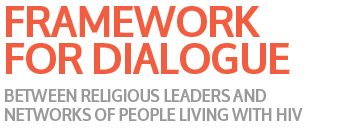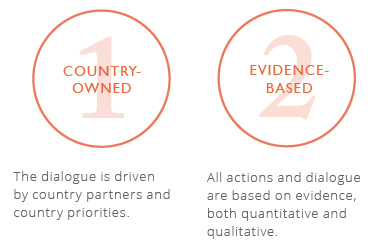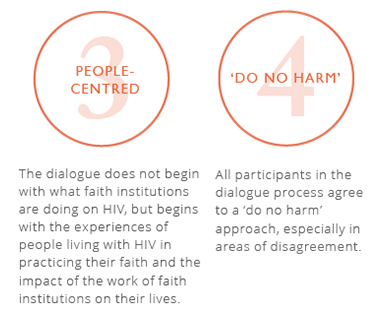While the Framework for Dialogue is designed to be adapted to different national contexts, the methodology in each country follows the model of evidence-to-dialogue-to-joint action.
More specifically, the Framework for Dialogue builds upon the results of the People Living with HIV Stigma Index. It uses these results generated by the national network of people living with HIV – complemented by other evidence gathered in the country – as a basis for guiding dialogue participants (both religious leaders and people living with HIV) from informal to formal discussions and actions, and from bilateral conversations to comprehensive and inclusive dialogue and collaborations.

Early on in the Framework for Dialogue process, a face-to-face dialogue meeting is held to analyse and discuss the evidence and to identify a list of joint actions for religious leaders and people living with HIV, as well as a list of topics for more in-depth dialogue. The national working group has the responsibility for initiating and organizing this dialogue meeting, and, more crucially, ensuring ongoing follow-up and dialogue according to the eight principles of the Framework for Dialogue.
Background:
The Framework for Dialogue was launched in August 2013. It is a joint project of the Ecumenical Advocacy Alliance (EAA), the Global Network of People Living with HIV (GNP+), the International Network of Religious Leaders Living with or Affected by HIV or AIDS (INERELA+) and UNAIDS.
The initial concept for this tool emerged from the 2010 Summit of High-Level Religious Leaders. Since then, key stages of its development have included:
- evidence gathering and analysis to inform the drafting of the Framework, including a multi-country faith-based lens analysis of People Living with HIV Stigma Index reports and an online survey to assess perceptions and expectations of dialogue stakeholders towards each other.
- testing of the Framework methodology in three national contexts (Malawi in June 2012, Myanmar in November 2012 and Ethiopia in April 2013).
- adaption and finalization of the full Framework for Dialogue text and methodology.
- development of a roll-out strategy.




